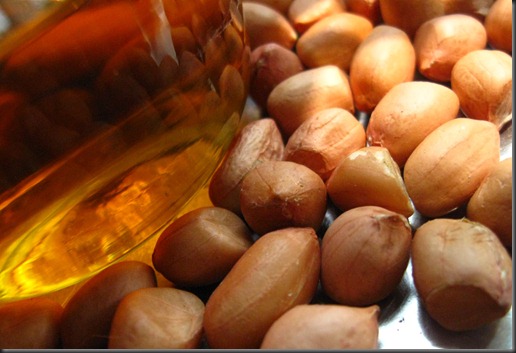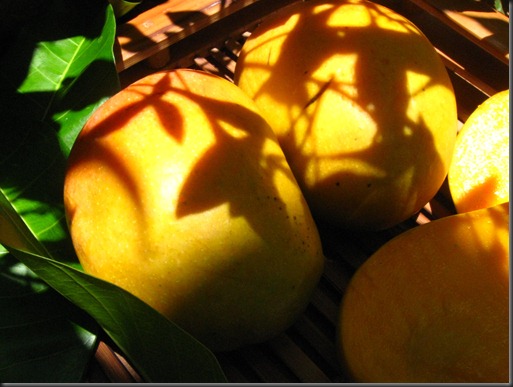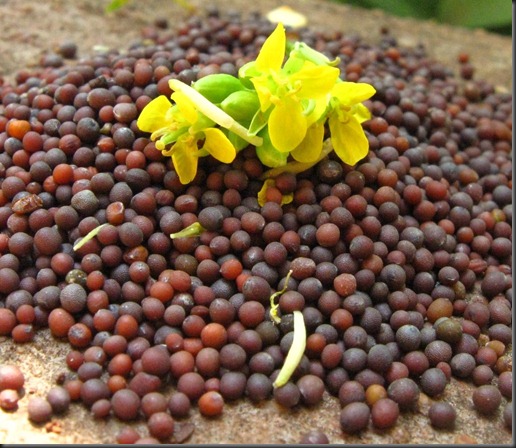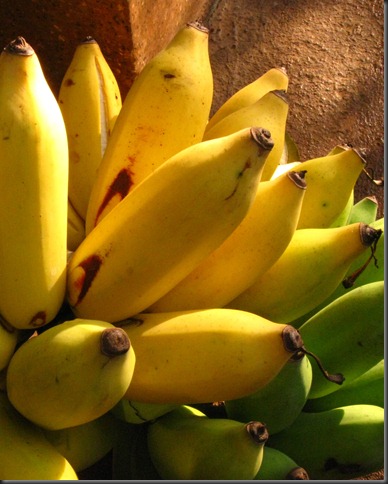There was a time not so long ago when you could tell the seasons by what your vegetable and fruit vendors were stocking. For example when carrots and cauliflowers made their appearance, we knew it was winter. Summer welcomed mangoes, green and tart and was so pickle making time. Then as they ripened into luscious, golden glory and the fat prickled hippos of jackfruit waddled in, you could smell in the rain clouds, pregnant and dark with the monsoons in their fragrant flesh.
But now, it’s winter all year around. Or summer. Or spring, depending on what your favourite fruit or vegetable. Personally speaking, after the novelty of having cauliflower all year round wore off, now it is just plain boring. What I mean to say is that things are so much more delectable – be that love or litchis - when you have to wait for them, crave for them and when it’s not always there, waiting patiently for you on that supermarket shelf. So apples throughout the year kind of lose their charm. I like it better when winter is signalled by the golden glow of oranges warming the street corners as the fabulous smoky aroma of peanuts roasting in pools of hot sand sidles up my nostrils to tell me winter is here. I find summer heat more bearable in the company of the crimson-pink, crunchy-cool slices of watermelons and monsoons would be unthinkable without hot roasted corn on the cob, wrapped in tantalising chiffon dupattas of lemon juice, chili powder and salt to sink my teeth into.
But, gratification of the taste buds apart, there are a few other important reasons why it is a good idea to eat what is in season….
Nature knows best…
Robed in pale silk plumes of kasa blooms,
full-blown lotuses her beautiful face,
the calls of rapturous wild geese
the music of her anklet bells,
ripening grain, lightly bending, her lissome form:
Autumn has now arrived, enchanting as a bride. Kalidasa’s Ritusamaharam, translated by Chandra Rajan in “Kalidasa -The Loom of Time”
First, the most important reason – eating seasonally is good for health. Actually, it’s quite obvious isn’t it? Just as you wouldn’t wear heavy woollens in the height of summer or thin muslin in the middle of winter, what you put into your body should match the season as much as what you put on it.
And who understood this better than the great, wise sages Charaka and Sushrutha, because eating by the season or Ritucharya is an important health regimen in Ayurveda. “Ritu” means season and “charya” means regimen or routine. In India we fix the seasons by following the sun. And so we have six not four seasons, each with a beautiful name. When the sun seems to begin to move in a Northerly direction (actually, it is the earth that is moving to circle the sun, but we’d like a little leeway on that), it is the beginning of the season called Shishir (approximately January and February), inaugurated by the festival of Makar Sankranti. Then, as things begin to warm up, it is spring or Vasant (approximately March and April) and that is the reason why Holi is often called Vasant Utsav. And when the sun is at its fiercest and harshest proximity to the earth, it is summer or Grishma (approximately May and June).
Then, the sun seems change course, moving in a southerly direction. As it does, there is reprieve for the parched, breathless earth as the rain clouds gather to dim its intensity and soon, we gratefully welcome the rainy season or Varsha (approximately July and August). This is followed by autumn or Sharad (approximately September and October) which gently cross fades in the crisp cool air and jewel blue skies - winter or Hemant, (approximately November and December).
And as the weather outside changes with each season, so do all organisms. their metabolic activity affected in a specific set of ways. That includes us humans. For example, in the first three seasons, (called adana in Ayurveda), as the sun progressively gets fiercer and stronger and sucks up the moisture, we slowly begin to dry out, loosing vigour and by the time it summer, we feel drained out and low on energy. Then the rains come, giving a chance to all creatures to rejuvenate, revitalize and restock. This is the beginning of the second set of three seasons (called visagra in Ayurveda) and culminates in winter, when we are at our peak in terms of energy and digestive powers.
The best way to deal with the effect of the weather is to eat whatever is in season. And that is exactly what Ritucharya is - simply eating whatever Mother Nature serves up, because like all mothers, she knows best. And so in each season, she stocks her orchards and fields and gardens only with what we need to eat to be healthy and fit.
For example, in summer, we need foods that are low on pungency and easy to digest because this is when our digestive fires are at their weakest, dimmed by the fierceness of the sun. The depletion of fluids and the heat also means that we also need foods that are essentially cooling in nature and high in moisture content. Right away, this means oodles of fruit and look how Nature obliges us with a gorgeous Indian summer fruit festival - watermelons, melons, jamuns, mangoes, litchi and bael fruit to name only a few. Similarly, summer vegetables are also specially designed to top up depleted moisture content in our body and leading the parade is are many members of the gourd family. Cucumbers and many others of the gourd family like bottle gourd (lauki), red pumpkin and snake gourd. And a plethora of soothing, moisture-rich greens like Malabar spinach, amaranth and dill.
Winter, on the other hand is when our digestive fires at their peak and we are burning up more energy because of the cold. So, Nature’s bounty is filled with hearty, warming foods, high in energy. Legumes like peanuts and all kinds of beans and dals, tubers like yam and sweet potato, vegetables like carrots, turnips, cauliflower and radish, warming seeds like sesame and mustard. It is also the time for spices to do their warming, aromatic magic! Incidentally, according to Ayurveda, the healthiest period of the year is November to January. And I’d like to think that it is not just a happy coincidence that many religious festivals are in this period - festivals means heavy festive fare and this is the season that our digestive systems are geared up for it!
So, eat whatever is in season because it has been meticulously custom-built to keep you healthy….
Out of season, out of nutrition
“Shipping is a terrible thing to do to vegetables. They probably get jet-lagged, just like people. “ Elizabeth Berry
Still longing for those out-of-season green peas? Then let me share some data that only corroborates what our ancient sages knew so very long ago. In a 1997 study conducted by the Ministry of Agriculture, Fisheries and Food in London, significant seasonal differences were found in the nutrient content of pasteurized milk. The summer milk was higher in beta-carotene because the cows ate more fresh plants in the summer. Similarly, researchers in Japan found three-fold increase in the vitamin C content of spinach harvested in summer versus winter. Also, nutrients are delicate darlings and deplete easily, affected by temperature, light and time. For example, spinach stored at room temperature loses between 50 and 90 per cent of its vitamin C content within 24 hours of being picked.
So think about it.
If you are gorging a mango in winter, it is has either travelled very long distances from its home town and so is now an exhausted, tired mango with little by way of nutrition, even though it make look otherwise. Or it has languished in some cold storage facility, its nutrients long frozen to death. Or worse still, it was probably picked when it was still immature and when all the nutrients didn’t get a chance to maximize themselves, then gassed or chemically treated to make it artificially ripen and look pretty when it gets to your table. Either way, I don’t need research data to convince you that there can’t be very much nutrition inside that fruit.
Be your farmer’s friend.
If you tickle the earth with a hoe she laughs with a harvest. - Douglas William Jerrold
We are a nation of farmers, 75% of us are economically dependent on agriculture and most our farmers are small or marginal farmers with half of all farms in India being less than one hectare in size. When we eat what is grown locally and in the season, we do many things to help the small farmer and his farm. We encourage farming practices that helps the land to retain its fertility. For example, we help to revive the old Indian tradition of multi-cropping, where many types of crops are grown at the same time (often as many as 21!), providing great symbiotic synergies agriculturally. So, when tomatoes are grown with onions and marigold – all winter produce - the marigolds act as insect repellent while the onion “ploughs” the soil when it is harvested. When mustard is grown along with or Bengal gram (channa), the yield of both crops improves and the chickpea plants fertilise the soil by fixing nitrogen.
Other wonderful things also happen. The fertility of the soil improves and pests and weeds have a hard time. But most importantly, the farmer has greater elbowroom to earn more, feed his own family better and if one crop fails, he always has other to fall back on.
But, because the quantities grown are small and the farmer does not have money to store or transport to far away places, this is only possible if the farmer is able to sell his easily perishable produce locally – at a nearby market or mandi. And that can only happen only if we eat whatever he grows, season by season….
For Taste’s Sake….
“When you eat local seasonal produce, you are ingesting something that basked in the same sun as you did, was bathed in the same rains, and thrived on the same air. Cooking with the season imparts fundamental things – flavour, nutrition and physical and spiritual connection to our farmer, our communities, our ancestors, our earth...” Eco-Foods Guide by Cynthia Barstow
Last but not the least, foods that are in season simply taste great. Why shouldn’t they when they have been recently kissed and caressed by the sun, infused with the blessing of the rain gods and freshly emerged from the vast, bountiful womb of Mother Nature, bursting with nourishment? So, as far as healthy eating goes, it all boils down to a very simple thumb rule. Eat what is in season and eat what grows locally because when you do this you are eating what is fresh off the branch. And that means the maximum amount of nutrition and the maximum amount of taste.
In March 2009, Michelle Obama went public with her agenda to get Americans to eat healthier and it included getting them to eat more fresh, locally grown produce. In this context, she recently said, “When you grow something yourself and it’s close and it’s local, oftentimes it tastes really good.”
Two hundred years ago, the poet John Keats said it more poetically!
“Season of mists and mellow fruitfulness!
Close bosom-friend of the maturing sun;
Conspiring with him how to load and bless
With fruit the vines that round the thatch-eaves run;
To bend with apples the mossed cottage-trees,
And fill all fruit with ripeness to the core;
To swell the gourd, and plump the hazel shells
With a sweet kernel…..”







No comments:
Post a Comment